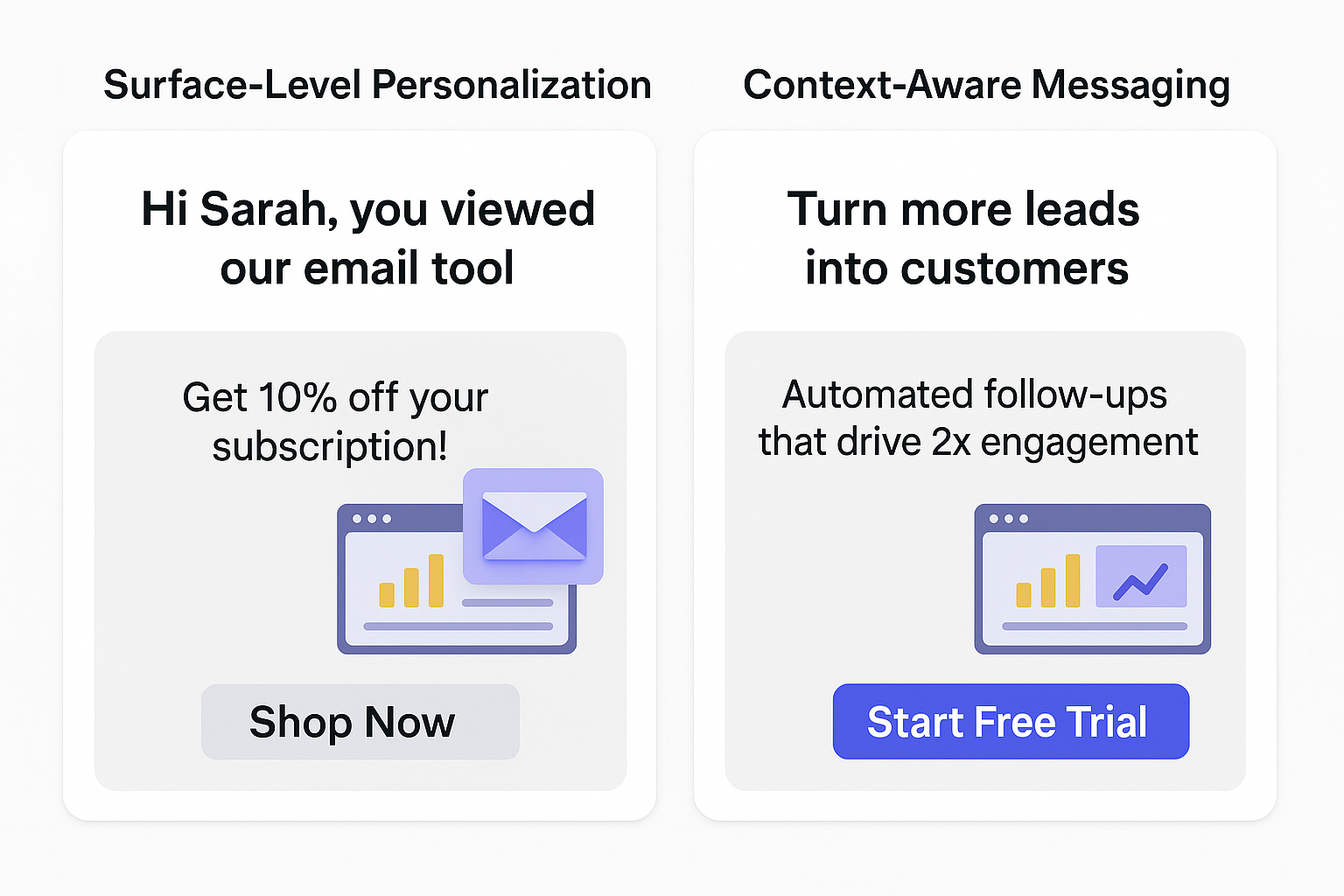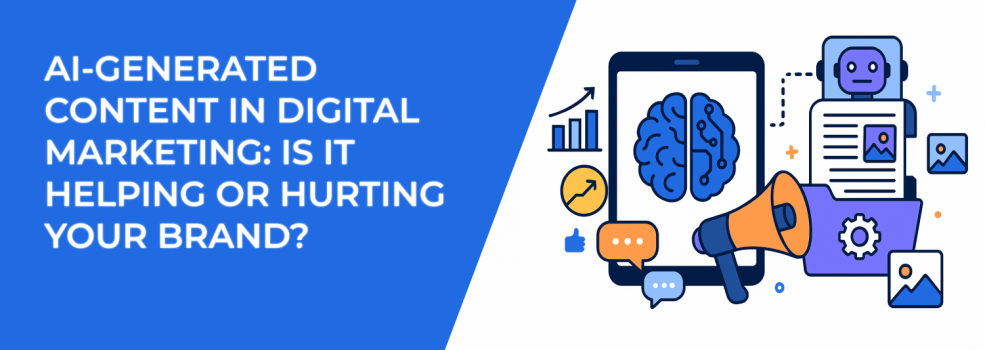AI tools are everywhere. They're fast, cheap, and getting better by the day. But if you're a marketer, brand strategist, or advertiser, the real question isn't how advanced AI is — it's whether it's actually helping your brand grow.
So let's break it down. Is AI-generated content pushing your brand forward? Or quietly eroding trust and performance behind the scenes?
Why Marketers Are Using AI Content in the First Place
Speed, scale, cost-efficiency.
That’s what AI promises — and often delivers. You can now create blog posts, product descriptions, ad copy, or email campaigns in a fraction of the time.
This matters for lean teams or early-stage startups. Content bottlenecks are real, and AI seems like a lifeline.
But there’s a tradeoff most people don’t talk about enough.
The Hidden Risks: What AI Misses (That Your Audience Won’t)
AI-generated content can look polished at first glance. But underneath, it often lacks something essential — context, originality, and human nuance.

Here’s what to watch out for:
-
Lack of brand voice — AI can mimic tone, but it doesn't understand your positioning, values, or audience pain points the way a strategist does. The result? Vague, interchangeable content that feels off.
-
Factual accuracy issues — Many AI models are trained on data that's outdated or incomplete. This can lead to subtle misinformation — and in regulated industries, that’s a real liability.
-
Repetition and SEO noise — AI loves to play it safe. It tends to recycle familiar phrases and overuse high-volume keywords without considering search intent. You may rank for some terms, but your bounce rates and engagement will tell a different story.
If you’re relying on AI to write copy that converts, you’ll also want to watch your click-through rates (CTR) closely. Low CTRs could be a sign your copy lacks the specificity or emotional hooks real users respond to — something covered in this breakdown of what causes CTR drops.
AI Copy vs. Human Copy: The Conversion Gap
Marketers are starting to notice a performance dip when relying too heavily on AI for landing pages, product ads, or retargeting sequences.
Why?
Because even small elements — a call-to-action, a product angle, a headline structure — can swing CTRs and conversions. And AI often chooses the "most average" version of these, not the most effective.
Real users respond to specificity. If your AI copy is generic, your results will be, too.
Here’s what human-crafted content still does better:
-
Understands and applies buyer psychology in context.
-
Reflects up-to-the-minute market trends and competitive angles.
-
Takes calculated creative risks that make messaging stand out.
-
Integrates cleanly with audience segmentation strategies.
Curious about how AI tools are evolving to support human writers rather than replace them? This round-up of top AI text and image tools shows where they shine — and where they fall short.
So Should You Ditch AI Content Altogether?
Not at all.
The smarter move isn’t avoiding AI — it’s knowing when and how to use it. While AI gives you speed, scale, and structure, it can’t replace what marketers do best: make strategic, human-informed decisions based on real audience understanding.
Think of it this way: use AI for efficiency. Use your judgment for resonance.
Here’s how marketers are using AI content effectively — without damaging brand trust or performance:
1. Draft Generation — Start Fast, Then Humanize
AI is great for getting past the blank page. Use it to:
-
Draft blog outlines or product descriptions.
-
Generate first-pass social captions.
-
Structure email nurture sequences.
But don’t publish straight from the prompt.
Why? AI copy often sounds generic. For example:
AI: “Boost your business with our all-in-one solution.”
Human rewrite: “Get 2x more qualified leads — without chasing cold traffic.”
Always refine for tone, accuracy, and originality before publishing.
2. SEO Research — Good for Clustering, Less Reliable for Judgment
AI can help you brainstorm:
-
Long-tail keyword variations.
-
Related questions for blog posts.
-
Content cluster ideas.
But it doesn’t understand search intent. That means it may suggest the wrong type of content — like recommending a product page when users are looking for an explainer.
Use AI for ideation. Then use tools like Google Search or keyword planners to validate recommendations. This step-by-step guide is a helpful resource for refining strategy.
3. A/B Testing Variants — AI Handles Volume, You Choose Quality
If you need copy variations quickly, AI can help with:
-
Facebook ad headlines.
-
Email subject lines.
-
Landing page intros.
Try this prompt:
“Write five ad headlines targeting e-commerce marketers dealing with abandoned carts. Use different angles and emotional triggers.”
From there:
-
Filter out anything off-brand or vague.
-
Run your best options in a split test.
-
Track click-through rates, conversions, and engagement to select the best performer.
For better outcomes, make sure your campaign structure aligns with your objective. See Meta Ad Campaign Objectives Explained.
4. Personalization — Only Works with Context
AI can tailor messages using inputs such as:
-
Customer name.
-
Viewed product.
-
Funnel stage.
But without the right context, even personalized copy can fall flat.

For instance:
“Hi Sarah, you viewed our email tool — here’s 10% off.”
Effective if Sarah is considering a purchase.
Irrelevant if she was casually browsing.
To personalize well:
-
Segment leads by behavior, such as cart abandoners versus top-of-funnel browsers.
-
Adjust tone and CTA urgency based on user intent.
-
Keep the message human, not just data-driven.
In the end, personalization isn’t about inserting data points — it’s about understanding intent. When AI-driven messaging feels genuinely relevant, it enhances the customer experience instead of interrupting it.
A Word About Authenticity and Brand Trust
Here’s the part that’s harder to measure — but just as critical.
Audiences are starting to notice when something feels AI-generated. The flood of bland, over-optimized content is creating fatigue. If your brand sounds like everyone else, you become forgettable.
In a world of sameness, the real edge is sounding human.
Even for paid ads, small moments of voice, clarity, or personality can increase engagement. Don’t let AI flatten what makes your brand distinct.
Need to revive your Facebook ads after a performance drop? This CTR fix guide dives into how better copy — human or human-guided — makes the difference.
Final Takeaway: Find the Balance
AI-generated content is here to stay. And when used well, it can speed up production and unlock creative possibilities.
But when it becomes the default, quality suffers.
So ask yourself:
-
Are you using AI to enhance or replace human strategy?
-
Are your messages tuned to your audience — or just checking SEO boxes?
-
Would you feel proud showing this copy to a real customer?
If the answer is no, it might be time to revisit your process.
Because in the end, content should serve your brand — not just the algorithm.

